Segments & Opportunities
Home » Segments & Opportunities

Understand the Customer – Develop a Plan – Deliver Success
Gain insights into the largest and fastest growing areas of the marketplace, using Schönox’s Market Segments and Opportunities reports. Each report covers four areas:
- Overview: A look at what drives the segment
- Decision Makers and Project Planners: Discussion of who places projects and how
- The Numbers: The size and scope of the segment
- Subfloors, Project Needs, and Opportunities: Subfloor issues and solutions for each
Across the US, more than 5.9 million buildings hold 97 billion square feet of commercial floor space. Each day, roughly 19 million square feet of commercial space is renovated. Priorities, specifications, and project needs vary by industry within the commercial sector. Schönox Market Segments and Opportunities reports address these commercial segments:
- Education: (13.6 billion sq. ft. / 14% of total)
- Health Care: (4.0 billion sq. ft. / 4% of total)
- Hospitality: (7.0 billion sq. ft. / 7% of total)
- Retail: (10.8 billion sq. ft. / 11% of total)
- Office: (16.7 billion sq. ft. / 17% of total)
The residential sector is made up of multifamily and standalone homes. Schönox provides reports on both segments. Roughly 18% of the US population lives in multifamily housing – that’s 57.9 million people living in 27.6 million apartments, and multifamily living is only growing in popularity. The size of the standalone home sector in the US is immense with area totaling over 257 billion square feet – that’s 2.6 times the size of all commercial space.
Need more insights into a particular market segment or support assembling a strategic subfloor plan for a customer? Contact us directly or use the Find a Rep function to connect with us.
Healthcare

Differentiated by its interdependence and linkages across its stakeholders, the health care industry presents complexities and opportunities beyond many other industries. Hospitals, outpatient facilities, clinics, physician offices, diagnostic facilities, medical schools, and rehabilitation centers are highly integrated, providing interconnected services, and often have common ownership or management in systems across cities and regions. Many health care facilities operate 24/7/365 or something close to it. They share personnel, expertise, and a common body of practices and procedures.
Decision Makers and Project Planners
Within health care operations, purchasing departments, facility & design planners, maintenance teams, administrators, and business managers make planning and purchasing decisions. The larger the facility, the more common it is for these personnel to be in house and their scope of responsibilities extensive. In addition to these in-house teams, many architecture and design firms specialize in health care or have health care-focused groups.
The Numbers
US health care spending reached $4.1 trillion last year. Putting that number into perspective is challenging. Think of it this way – US health care spending is greater than the GDP (economy) of California and greater than the combined GDP of the 27 smallest states in the US. In many cities, the local health system or hospital is the largest employer. Health care represents 17.8% of the total economy but only 4% of total US commercial square footage, suggesting the high revenue per square foot of the services delivered in those spaces.
FLOORS AND FACILITIES:
4,018,000,000: Health care square footage
9,000: Inpatient facilities
35: Median age (years) of inpatient facilities
129,000: Outpatient facilities
29: Median age (years) of outpatient facilities
251,000: Average square footage of inpatient facility
907,426: Companies in the US health care sector
ECONOMIC STATS:
17.8%: Portion of US economy devoted to health care
$4.1 trillion: US health care spending
$12,349: Health care spending per person in US
$8.3 trillion: Expected US health care spending in 20 years
22,261,000: US health care industry employment (14% of all employment)
FLOORS AND FACILITIES:
4,018,000,000: Health care square footage
9,000: Inpatient facilities
35: Median age (years) of inpatient facilities
129,000: Outpatient facilities
29: Median age (years) of outpatient facilities
251,000: Average square footage of inpatient facility
907,426: Companies in the US health care sector
ECONOMIC STATS:
17.8%: Portion of US economy devoted to health care
$4.1 trillion: US health care spending
$12,349: Health care spending per person in US
$8.3 trillion: Expected US health care spending in 20 years
22,261,000: US health care industry employment (14% of all employment)
Subfloors, Project Needs, and Opportunities
The broad scope of the health care industry segment is matched by the scope of its subfloor projects. Health care facilities are almost always expanding, renovating, or remodeling some portion of their campus or have plans to do so. Important subfloor issues include:
| Issue | Details | Schönox Solution |
|---|---|---|
| Quick project turns | Facilities open 24/7 and areas costly to shut down for renovation | Schönox Need for Speed™ systems |
| Occupied patient spaces | Renovation work completed near areas in full use | Subfloor products with low dust and odor |
| Specialty subfloor needs | Areas such as MRI rooms with copper subfloors | Cover with Schönox synthetic gypsum self-leveling compounds |
| Environmental concerns | Requirements for projects and processes | The Schönox commitment to support environmentally-responsible projects |
| Subfloor renovation without demolition | Existing subfloors come with issues leading some to consider subfloor demolition | Schönox subfloor Renovation without Demolition |
| Extreme durability | Stretchers, wheel chairs, and other equipment focus weight on small areas | Schönox self-leveling compounds with outstanding compressive strength |
Health care is increasingly competitive with health care providers competing for patients and staff, differentiating themselves from competitors with exceptional facilities, staff, and specialties. Renovation and new construction projects often have high profiles within the health care organizations and communities at large. Schönox subfloor solutions provide technologically-advanced, environmentally-focused options consistent with the heath care industry’s mission.
Retail
 Stores are getting better and better for consumers. Brick-and -mortar retailers have been under assault by internet-based retailers for roughly two decades. US consumers have evolved in their shopping habits, willing to buy increasingly expensive and complex items online, impacting traditional stores. Retail internet sales are roughly $890 billion (13%) of the $6.9 trillion in annual retail sales overall.
Stores are getting better and better for consumers. Brick-and -mortar retailers have been under assault by internet-based retailers for roughly two decades. US consumers have evolved in their shopping habits, willing to buy increasingly expensive and complex items online, impacting traditional stores. Retail internet sales are roughly $890 billion (13%) of the $6.9 trillion in annual retail sales overall.
Retail Reaction to the Internet
Brick-and-mortar retailers reacted to the rise in internet retail in one or a combination of three ways including: closing lesser-performing stores, enhancing the store presence, and/or blending the in-store and online experiences. Many brick-and-mortar stores have leveraged their physical presence by providing pick up and return of products purchased online. Retailers who concentrate on providing a shopping experience for customers have expanded their store renovation rates and taken fresh looks at their store designs. The enhanced competition ushered in a wave of retail innovation at full speed today.
Internet & Bricks-and-Mortar
Many native online retailers are now opening brick-and-mortar stores. Powerhouse Amazon has experimented with physical stores, most notably buying Whole Foods for $13.7 billion. Brick-and-mortar retail is not going away by a longshot, but the customer expectations and desired experiences have accelerated. Many retailers are meeting those demands. In-store shopping is still the preferred retail channel with 82% of Millennials preferring the brick-and-mortar experience.
Decision Makers and Project Planners
Decisions regarding retail renovation and new construction projects occur at different levels, depending on the size of the organization. Many larger retailers have entirely in-house store planning departments very similar to architecture and design firms. Others have a small staff who rely heavily on A&D firms and contractors for support. Many retail facilities are owned by real estate and investment firms who handle renovation projects on their own or in consultation with their tenants.
The Numbers
Roughly 1.04 million retail establishments in 517,000 facilities occupy 10.8 billion square feet in the US. Assuming a conservative retail floor renovation rate of once every 20 years indicates 1.5 million square feet of retail space is renovated every day of the year. More than 80% of Americans visit a retailer at least once per week. Roughly 1 in 21 Americans works in retail and just over 11% of all commercial space is retail.
FLOORS AND FACILITIES:
10,781,000,000: Retail square footage
517,000: Retail buildings
37: Median age (years) of retail buildings
166,000: Strip malls
1,000: Enclosed malls
296,000: US standalone stores
20,852: Average square footage of retail facility
1.04 million: Brick-and-mortar retail stores
2.9 million: Retail businesses
ECONOMIC STATS:
30%: Retail portion of the US economy
$6.9 trillion: US retail spending
$20,783: Retail spending per person in US
15.4 million: US retail employment (9.8% of all employment)
FLOORS AND FACILITIES:
10,781,000,000: Retail square footage
517,000: Retail buildings
37: Median age (years) of retail buildings
166,000: Strip malls
1,000: Enclosed malls
296,000: US standalone stores
20,852: Average square footage of retail facility
1.04 million: Brick-and-mortar retail stores
2.9 million: Retail businesses
ECONOMIC STATS:
30%: Retail portion of the US economy
$6.9 trillion: US retail spending
$20,783: Retail spending per person in US
15.4 million: US retail employment (9.8% of all employment)
Subfloors, Project Needs, and Opportunities
Retailers know their store spaces, planning renovations years into the future with the desire for better aesthetics, performance, and store design. Better subfloors have an important role to play with the following issues and more:
| Issue | Details | Schönox Solution |
|---|---|---|
| Overnight, fast renovations | Some retailers have 24/7 operations and others can’t afford to be closed for renovation | Schönox Need for Speed™ systems |
| Renovations during store hours | Renovation work completed with customers in the store | Subfloor products with low dust and odor |
| Subfloor moisture | Slabs have moisture causing covering issues | Schönox moisture mitigation systems, moisture-resistant patch, self-leveling compounds, & adhesives |
| Subfloor contaminants including asbestos | Need to successfully cover rather than demo or remediate contaminants | Schönox EPA and EPA Rapid |
| Subfloor renovation without demolition | Existing subfloors come with issues leading some to consider subfloor demolition | Schönox subfloor Renovation without Demolition |
| Extreme durability | Shopping carts, pallet jacks, and customer traffic impact subfloors | Schönox self-leveling compounds with outstanding compressive strength |
| Environmental objectives | Requirements for products and processes | The Schönox commitment to support environmentally-responsible projects |
Retail is changing quickly, reacting to consumer desires for better store experiences. Store renovations are a necessity and subfloors are an investment in each. The most forward-leaning retailers are renovating 10 to 15% of their stores each year. Schönox speed, performance, and safety provide the strongest long-term retail outcomes.
Education

With its 13.6 billion square feet, the education segment encompasses more commercial space than health care and hospitality (lodging) combined. Two in seven Americans are students. Two-thirds of those students are in a K-12 school. One in eighty-five Americans is a K-12 teacher; over 4 million teachers comprising 2.5% of the working population. In many districts, the school system is one of the largest employers. Education facilities form the fabric of communities, often drawing public interest regarding performance, conditions, programs, and sporting events.
Colleges and universities employ roughly 1.3 million faculty members with growth of 3.5% in that figure over the past ten years. However, expected employment growth in the coming ten years of 12% is much higher than the average for all occupations. Overall, colleges and universities employ 2.9 million people; 45% faculty and 55% in other capacities. America’s 4,562 colleges and universities have just under 20 million students. Colleges and universities are cities unto themselves, encompassing broad commercial sector capacities and characteristics including health care, hospitality, restaurant and food service, retail, office, public affairs, infrastructure, and other areas.
 With its 13.6 billion square feet, the education segment encompasses more commercial space than health care and hospitality (lodging) combined. Two in seven Americans are students. Two-thirds of those students are in a K-12 school. One in eighty-five Americans is a K-12 teacher; over 4 million teachers comprising 2.5% of the working population. In many districts, the school system is one of the largest employers. Education facilities form the fabric of communities, often drawing public interest regarding performance, conditions, programs, and sporting events.
With its 13.6 billion square feet, the education segment encompasses more commercial space than health care and hospitality (lodging) combined. Two in seven Americans are students. Two-thirds of those students are in a K-12 school. One in eighty-five Americans is a K-12 teacher; over 4 million teachers comprising 2.5% of the working population. In many districts, the school system is one of the largest employers. Education facilities form the fabric of communities, often drawing public interest regarding performance, conditions, programs, and sporting events.
Colleges and universities employ roughly 1.3 million faculty members with growth of 3.5% in that figure over the past ten years. However, expected employment growth in the coming ten years of 12% is much higher than the average for all occupations. Overall, colleges and universities employ 2.9 million people; 45% faculty and 55% in other capacities. America’s 4,562 colleges and universities have just under 20 million students. Colleges and universities are cities unto themselves, encompassing broad commercial sector capacities and characteristics including health care, hospitality, restaurant and food service, retail, office, public affairs, infrastructure, and other areas.
Operations - Budgets
Education is big business. Public K-12 education operational spending topped $771 billion last year, reflecting increases in each of the past eight years. State and local governments provide 93% of school funding, controlling most school operations. The federal government contributes just 7% for school funding, closely directing the use of those funds through grants and specific programs.
Operating budgets for colleges and universities totaled $671 billion, split 2/3 with public and 1/3 with private institutions. Tuition and fees make up 20% of those budgets for public organizations and 34% for private. The remaining portion of their budgets come from federal and state grants, sales and services provided, endowment returns, gifts, and federal and state appropriations. Providers of these funds most often do so with stipulations and directives, guiding use of the funds. Vendors and service providers who meet or exceed these stipulations and directives win contracts and secure education industry business.
Decision Makers and Project Planners
Kindergarten through 12th Grade
Project decision making can involve many levels and varies depending on project size, funding, and scope. Maintenance staff at the district office often make project decisions, at times doing so in concert with outside contractors hired to renovate subfloors and complete floor covering projects. District offices also have financial officers and as the project size, scope, complexity, or impact across schools increases, the more likely it becomes for a superintendent and a school board to have involvement. The factors impacting decision making vary including cost, budget, funding method, the condition of existing infrastructure, environmental considerations, and competing project needs.
Elected school boards control most public districts, hiring superintendents who manage the schools within the district. Superintendents hire directors and assistants for their district teams as well as principals or heads of school for the individual schools. State level departments of instruction significantly impact public schools as well controlling, certain budget elements and varying degrees of instructional direction. Private schools are smaller in scope, with their own boards and management staff. Charter schools are hybrids with managerial elements taken from the public and private sectors often with boards separate from the public district to which they are most often a part.
Colleges and Universities
Management staff and leaders within colleges and universities juggle a wide variety of projects, programs, and commitments as diverse as those found within any city. Infrastructure needs, maintenance, renovation, and construction projects are handled at different levels depending on the size of those efforts and the size of the organization. Central planning, facilities, and maintenance departments administer projects from everyday needs up to mid-size efforts. Larger projects encompass deans, financial and procurement staff, and university officials in the decision processes. Infrastructure and capital projects often have directives and stipulations regarding materials, contractors, and processes to be used. Still larger projects may involve outside architecture and design firms, specializing in the education projects. Identifying project decision makers and the details for their projects is an investigative process requiring networking and asking questions.
The Numbers
With 13.6 billion square feet in over 437,000 buildings, the education sector in the US occupies vast amounts of space. While education utilizes 14% of all commercial space, the sector commands just 6.1% of US GDP. Investments in building space are made and those structures used for many decades. In fact, more than 51% of all education square footage is 40 years old or older. As such, renovation projects are needed by a high percentage of facilities. Limited capital budgets across education organizations flow to those renovations rather than new construction which most often required funding outside of normal budget processes.
FLOORS AND FACILITIES:
13,623,000,000: Education square footage
14%: Commercial square footage devoted to education
437,000: Education buildings
10,619,000,000: K-12 square footage
264,000: K-12 buildings
1,827,000,000: College/university square footage
60,000: College/university buildings
39%: Portion of education square footage 50 years or older (5.4 billion sq.ft.)
51%: Portion of education square footage 40 years or older (7.0 billion sq.ft.)
78%: Education floor space government-owned
71%: Portion of education buildings with greater than 50,000 sq ft each
ECONOMIC STATS:
6.1%: Portion of the US economy devoted to education
$1.4 trillion: US education spending
56,800,000: Public school students
5,700,000: Private school students
20,000,000: University students
12,400,000: Community college students
94,900,000: Total students (29% of population)
3,158,000: K-12 public school teachers
473,000: K-12 private school teachers
FLOORS AND FACILITIES:
10,781,000,000: Retail square footage
517,000: Retail buildings
37: Median age (years) of retail buildings
166,000: Strip malls
1,000: Enclosed malls
296,000: US standalone stores
20,852: Average square footage of retail facility
1.04 million: Brick-and-mortar retail stores
2.9 million: Retail businesses
ECONOMIC STATS:
30%: Retail portion of the US economy
$6.9 trillion: US retail spending
$20,783: Retail spending per person in US
15.4 million: US retail employment (9.8% of all employment)
Subfloors, Project Needs, and Opportunities
Vast spaces, limited dollars, increasing utilization rates, and high environmental, sustainability, and performance standards characterize the education sector’s infrastructure situation. While those factors can be challenging, the size of the education opportunity easily warrants efforts to meet project needs with subfloor products meeting the industry’s needs.
| Issue | Details | Schönox Solution |
|---|---|---|
| Longevity and durability | Renovations must last decades. They are not remodels. They are renewals needed to last. | Schönox self-leveling compounds with outstanding compressive strength |
| Summer projects | Many education projects occur in the summer months with limited project timelines. | Schönox Need for Speed™ systems |
| Occupied student spaces | Renovation work completed while students and staff are in use. | Subfloor products with low dust, odor, and VOCs |
| Environmental objectives | Requirements for products and processes | The Schönox commitment to support environmentally-responsible projects |
| Subfloor contaminants including asbestos | Need to successfully cover rather than demo or remediate contaminants | Schönox EPA and EPA Rapid |
| Environmentally responsible and economically feasible solution set | The sector must demonstrate environmental and fiscal responsibility with organized project pathways. | Schönox subfloor Renovation without Demolition |
| High performance paired with reasonable cost | Solutions must address project cost while also demonstrating long term performance | Integrated Schönox solutions sets which have lower costs but also notably lower labor costs |
The education sector requires advanced subfloor solutions capable of demonstrating positive economic, effectiveness, and environmental attributes. Schönox has the production solution sets to meet these objectives. No Schönox product will cause a school board member a moment’s concern. Use of Schönox products will delight the most environmentally discerning university administrator.
Hospitality 1
 The 184,596 hotels in the US provide more than 5.3 million rooms in the hospitality industry, generating $258 billion in annual revenues. The industry has produced some of the best-known brand names in the US, including Hilton, Marriott, Hyatt, Wyndham, Sheraton, Best Western, and many others. Perhaps no other industry was hurt more by the pandemic period, and its effects are still impacting the industry, if not changing it altogether. Business travel plummeted during the pandemic, and many travelers learned some new brand names, including Zoom, Go To Meeting, and Google Meet.
The 184,596 hotels in the US provide more than 5.3 million rooms in the hospitality industry, generating $258 billion in annual revenues. The industry has produced some of the best-known brand names in the US, including Hilton, Marriott, Hyatt, Wyndham, Sheraton, Best Western, and many others. Perhaps no other industry was hurt more by the pandemic period, and its effects are still impacting the industry, if not changing it altogether. Business travel plummeted during the pandemic, and many travelers learned some new brand names, including Zoom, Go To Meeting, and Google Meet.
Revenue per available room now exceeds expectations with growth in the industry linked to vacation or leisure travel rather than business travel which still lags. Many hotel brands are reporting returns to pre pandemic revenue per available room figures. Challenges remain, including available labor to staff facilities. Hotels must shift strategies to use more technology to handle workloads while outsourcing for many functions.
Competition is fierce as hotel guests increasingly look for unique experiences, amenities, sustainability awareness, heightened cleanliness, and blending of business and leisure travel. Average daily room rates have reached an all-time high in the industry even as guests consider non-chain hotels, boutique providers, and alternative lodging options with brands such as Airbnb and Vrbo. The industry is emerging from the pandemic, but is changing as it moves to serve quite different guest priorities.
Decision Makers and Project Planners
Throughout North America there are 6.3 million hotel rooms with almost half of those rooms owned by the top five companies (Marriott, Hilton, Wyndham, Choice, and InterContinental). The next five largest hotel companies control 9% of hotel rooms. These large hotel companies often have a number of brands within their portfolio with Marriott having the most at 30 unique hotel names. Around 40% of US hotels are independent, with an increasing number of new hotels fitting the boutique classification.
Major hotel brands operate sophisticated departments devoted to renovation, construction, architecture, and design of their hotels. These professionals often address every detail from initial planning and strategy to design, materials selection, and specifications through project execution and completion.
Many architecture and design firms specialize in the hospitality sector, handling projects for a wide variety of hotel customers. As the size of hotel companies decrease, the more likely it is for outside firms to be engaged for the work with accountability to hotel executives.
In addition, many contractors specialize in the hospitality industry and will select materials for projects based on specifications provided by hotel planning and procurement departments or outside firms. Knowing decision makers on the hotel or A&D side as well as the contractor side is necessary to follow the allocation of work and designation of project materials.
The Numbers
The hotel and lodging industry’s 6.98 billion square feet represent 7% of all US commercial square footage, but receive a greater amount of renovation dollars on a per square foot basis over time than most other industries. The rigors of the hospitality industry take a toll on the interior spaces from high traffic, food, luggage, carts, bath spaces, pools, and more.
Each room must be renovated every 5 to 10 years. That’s 2,900 hotel rooms each weekday, roughly 757,000 per year. Average room rates are now $149. If renovations on those 757,000 rooms take just ten days, that’s $1 billion in annual lost-room revenue industry wide. Keeping rooms available and in excellent condition and top the list among hotel industry concerns.
1. While the hospitality industry includes hotels, restaurants, bars, tourism, catering, and even theme parks – here we concentrate principally on hotels.
FLOORS AND FACILITIES:
6,976,000,000: Hotel & lodging square footage
7%: Commercial square footage devoted to hotels & lodging
207,000: Hotels & lodging buildings
28,700: Median square footage of hotels
32: Median age of hotels
1,525,000,000: Nursing home & assisted living square footage
38,000: Nursing home & assisted living buildings
840,000,000: Dormitory, fraternity, & sorority square footage
35,000: Dormitory, fraternity, & sorority buildings
5-10: Average year cycle for renovations
ECONOMIC STATS:
$258,000,000,000: Hotel industry revenues
5,562,756: Number of US hotel rooms
2,245,000: Hotel industry employment
62.7%: Average hotel room occupancy
$148.83: Average daily room rate (all-time record)
$12,040,000,000: Hilton’s brand value
FLOORS AND FACILITIES:
6,976,000,000: Hotel & lodging square footage
7%: Commercial square footage devoted to hotels & lodging
207,000: Hotels & lodging buildings
28,700: Median square footage of hotels
32: Median age of hotels
1,525,000,000: Nursing home & assisted living square footage
38,000: Nursing home & assisted living buildings
840,000,000: Dormitory, fraternity, & sorority square footage
35,000: Dormitory, fraternity, & sorority buildings
5-10: Average year cycle for renovations
ECONOMIC STATS:
$258,000,000,000: Hotel industry revenues
5,562,756: Number of US hotel rooms
2,245,000: Hotel industry employment
62.7%: Average hotel room occupancy
$148.83: Average daily room rate (all-time record)
$12,040,000,000: Hilton’s brand value
Subfloors, Project Needs, and Opportunities
Renovations aren’t an occasional inconvenience for hotels. Instead, they’re part of the business and operational plans. Hotel executives know they must deliver outstanding experiences to customers which include the aesthetics, performance, and branding of the floor surfaces. Safety and durability rank highly on the list of considerations as well. The frequency, scale, and required quality of hotel renovations make this commercial sector a logical fit for Schönox and flooring professionals.
| Issue | Details | Schönox Solution |
|---|---|---|
| Renovation turnover | Renovations must happen quickly to get rooms back in service. | Schönox Need for Speed™ systems |
| Environmentally responsible processes and products | A process that reduces environmental impact with safe subfloor products. | Schönox subfloor Renovation without Demolition |
| Occupied guest spaces | Renovation work completed while guests are present. | Subfloor products with low dust, odor, and VOCs |
| Environmental objectives | Requirements for products and processes. | The Schönox commitment to support environmentally-responsible projects |
| Subfloor moisture | Slabs have moisture causing covering issues. | Schönox moisture mitigation systems, moisture-resistant patch, self-leveling compounds, & adhesives |
| Acoustic solutions | Integrated Schönox sound barriers with subfloor preparation materials. | Schönox sound and underlayment system. |
The hospitality sector requires speed, durability, and environmentally responsible solutions for renovations and new construction. Hotel brands must deliver customer experiences with availability across all their room inventory. Schönox delivers renovation speed, subfloor processes that can be used in occupied spaces, and environmental benefits pleasing to customers and stakeholders.
Office
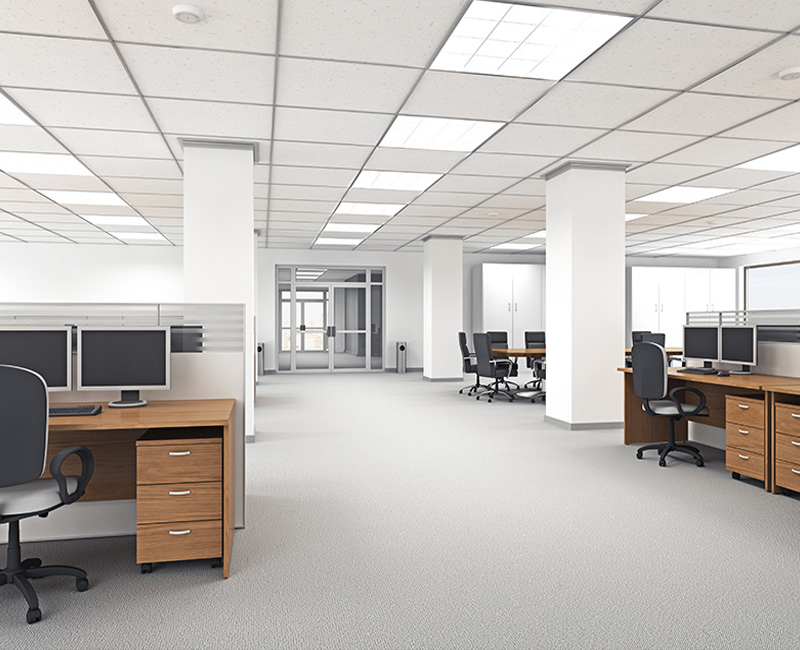
The scope, diversity of work, and financial influence of office real estate cannot be overstated. Indeed, most of the economy is directed, managed, and monitored from within the office sector. Administrative and professional services utilize 9.2 billion square feet of commercial space (56% of office space and 10% of all commercial space). Mixed-use facilities are growing quickly, representing 3.4 billion square feet (20% of office space and 4% of all commercial space). Government agencies occupy 2.5 billion square feet (15% of office space and 3% of all commercial space).
Demand remains high among office spaces in the fastest growing markets (9 of which are in the South and Southeast). Many core business districts are struggling with higher vacancy rates. In addition, a split has occurred with prime office spaces doing well, while secondary office buildings seeing lesser demand. The impact of trends such as work-from-home (see more on that below) are certainly influencing office space demand, but so are a lower number of workers overall. New office space construction is down 27% as developers respond to vacancies and changing priorities such as office placement for shorter commutes and demand for greater amenities. In many areas, rental rates are down by 25% and in others, declines of 40% have been seen. Competition for new tenants is fierce.
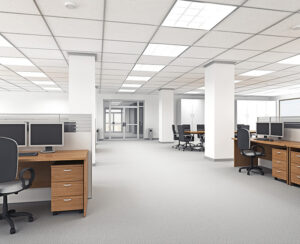 The scope, diversity of work, and financial influence of office real estate cannot be overstated. Indeed, most of the economy is directed, managed, and monitored from within the office sector. Administrative and professional services utilize 9.2 billion square feet of commercial space (56% of office space and 10% of all commercial space). Mixed-use facilities are growing quickly, representing 3.4 billion square feet (20% of office space and 4% of all commercial space). Government agencies occupy 2.5 billion square feet (15% of office space and 3% of all commercial space).
The scope, diversity of work, and financial influence of office real estate cannot be overstated. Indeed, most of the economy is directed, managed, and monitored from within the office sector. Administrative and professional services utilize 9.2 billion square feet of commercial space (56% of office space and 10% of all commercial space). Mixed-use facilities are growing quickly, representing 3.4 billion square feet (20% of office space and 4% of all commercial space). Government agencies occupy 2.5 billion square feet (15% of office space and 3% of all commercial space).
Demand remains high among office spaces in the fastest growing markets (9 of which are in the South and Southeast). Many core business districts are struggling with higher vacancy rates. In addition, a split has occurred with prime office spaces doing well, while secondary office buildings seeing lesser demand. The impact of trends such as work-from-home (see more on that below) are certainly influencing office space demand, but so are a lower number of workers overall. New office space construction is down 27% as developers respond to vacancies and changing priorities such as office placement for shorter commutes and demand for greater amenities. In many areas, rental rates are down by 25% and in others, declines of 40% have been seen. Competition for new tenants is fierce.
The Trends Provide a Flooring Opportunity
No segment of the real estate sector experienced greater impacts from the pandemic, office shutdowns, and the emerging work-from-home trend than the office segment. Many employers are insisting workers come back to the office, if only for some portion of the week, but tight labor markets are conversely pressuring employers to cater to workers, especially those with special skills.
The clear result from the work-from-home trend is less demand for office space. Many office real estate experts suggest 10 to 20% of office space will need to be removed from the market or repurposed for other uses. But another trend is developing – remaining office spaces must compete for tenants based on aesthetics, performance, and amenities of the space. Employers are seeking office spaces in which employees want to spend time. So even as overall office space demand is decreasing, the demands for better office space is increasing. A substantial wave of office space renovation and remodeling has arrived.
Decision Makers and Project Planners
The diversity and broad scope of the office sector is reflected in those who make decisions and execute flooring renovation projects. Owners of office real estate include commercial property firms (of varying sizes from massive down to local operators), financial institutions, a wide variety of investment companies, and the office occupiers themselves.
Large scale renovation projects are often completed by the property owners in consultation with tenants. In other instances, the tenants will renovate their spaces in connection with the property owners or at times on their own. Knowing the office space owners as well as a property management firm the owners have put in place is the starting point. These groups will have first hand, current knowledge of where and when renovation projects will occur. The work may be assigned to an architecture and design firm or contractors, but the owners and management firm most often have knowledge of the projects and timing.
The Numbers
The office segment dominates American commercial real estate with 16.6 billion square feet spread across almost one million buildings. Larger than all other commercial segments except warehouse and storage, office real estate occupies a critical place in the lives of the roughly 33 million people who work in them and in the investment portfolios of the property firms, investors, and real estate trusts who own office spaces. With an overall $3.2 trillion property value, office real estate eclipses the other commercial segment values.
FLOORS AND FACILITIES:
16,662,000,000: Office square footage
17%: Portion of all commercial space devoted to office sector
970,000: Office buildings
38: Median age (years)
17,200: Average building square footage
5,000: Median building square footage
3,790: Number of flexible (coworking) workspaces
16.8%: Average office vacancy rate
ECONOMIC STATS:
3.2 trillion: Value of US office real estate
963 million: Unoccupied office space sq. ft.
$38: Average per sq. ft. rental price
-43.9%: NYC office market value decline since 2019
-18.5%: Decrease in office lease revenues since 2019
½: Portion of multi-national firms planning to cut office space in next 3 years
FLOORS AND FACILITIES:
16,662,000,000: Office square footage
17%: Portion of all commercial space devoted to office sector
970,000: Office buildings
38: Median age (years)
17,200: Average building square footage
5,000: Median building square footage
3,790: Number of flexible (coworking) workspaces
16.8%: Average office vacancy rate
ECONOMIC STATS:
3.2 trillion: Value of US office real estate
963 million: Unoccupied office space sq. ft.
$38: Average per sq. ft. rental price
-43.9%: NYC office market value decline since 2019
-18.5%: Decrease in office lease revenues since 2019
½: Portion of multi-national firms planning to cut office space in next 3 years
Subfloors, Project Needs, and Opportunities
While the office real estate sector is experiencing significant challenges, the enhanced competition for tenants provides opportunities for contractors renovating office spaces. Attracting and retaining tenants with strong aesthetics and high-performance spaces is paramount for office investors.
| Issue | Details | Schönox Solution |
|---|---|---|
| Uninterrupted space usage | Closing an office for renovation is not an option | Schönox Need for Speed™ systems |
| Occupied office spaces | Renovation work completed near areas in full use | Subfloor products with low dust and odor |
| No HVAC | Project areas often have no HVAC leading to material drying time issues | Schönox Hybrid Active-Dry Technology |
| Environmental priorities | Requirements for projects and processes | The Schönox commitment to support environmentally-responsible projects |
| Subfloor renovation without demolition | Existing subfloors come with issues leading some to consider subfloor demolition | Schönox subfloor Renovation without Demolition |
| Concrete slab moisture | Moisture is the #1 subfloor problem, leading to floor failures | Schönox moisture mitigation systems |
| Adhesives for diverse floor coverings | Office projects have many different floor coverings requiring different adhesives | Schönox adhesives |
The hospitality sector requires speed, durability, and environmentally responsible solutions for renovations and new construction. Hotel brands must deliver customer experiences with availability across all their room inventory. Schönox delivers renovation speed, subfloor processes that can be used in occupied spaces, and environmental benefits pleasing to customers and stakeholders.
Multifamily Housing
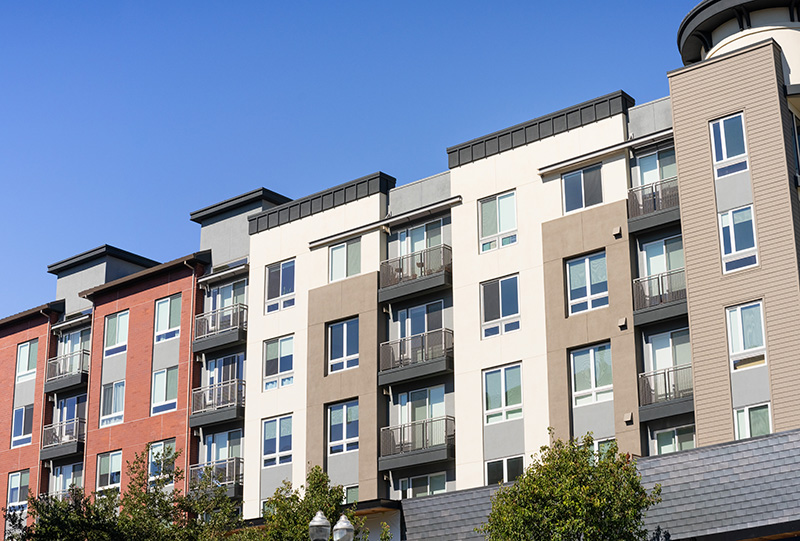
Once a stepping stone to home ownership for many, multifamily housing now serves longer term needs as Americans choose from among apartment facilities with outstanding amenities and options. Higher interest rates, lower standalone housing inventory, and increasing prices have made home purchases far more expensive in recent years, making apartment living more attractive.
Many in the millennial generation, but also within other generations, choose apartment living based on its greater flexibility, sense of community, and evolving benefits such as:
- Thoughtful and varied floor plans
- Enhanced outdoor spaces – porches, balconies, planters, gardens, trails
- Communal spaces for gathering and events
- Eco friendly buildings – solar, energy efficiency, charging stations
- Remote work spaces and internet access support
- Smaller apartments – less cost, most usable space
In recent years, multifamily housing vacancy rates plummeted, rents skyrocketed, and apartment demand increased. Much of the activity revolves around higher end units often selected by those actively choosing apartment life over standalone homes. Home ownership by millennials is well below previous generations and that trend is not likely to lose momentum any time soon.
As interest rates have risen, the construction of new multifamily units has declined. The steep rent increases of the 2020 to 2022 period have declined, returning to more normal increases along with vacancy rates which had reached all-time lows. The multifamily sector remains robust and healthy, but without the extraordinary growth.
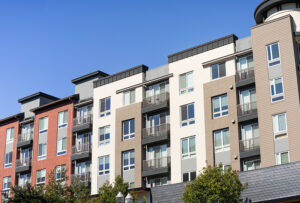 Many in the millennial generation, but also within other generations, choose apartment living based on its greater flexibility, sense of community, and evolving benefits such as:
Many in the millennial generation, but also within other generations, choose apartment living based on its greater flexibility, sense of community, and evolving benefits such as:
- Thoughtful and varied floor plans
- Enhanced outdoor spaces – porches, balconies, planters, gardens, trails
- Communal spaces for gathering and events
- Eco friendly buildings – solar, energy efficiency, charging stations
- Remote work spaces and internet access support
- Smaller apartments – less cost, most usable space
In recent years, multifamily housing vacancy rates plummeted, rents skyrocketed, and apartment demand increased. Much of the activity revolves around higher end units often selected by those actively choosing apartment life over standalone homes. Home ownership by millennials is well below previous generations and that trend is not likely to lose momentum any time soon.
As interest rates have risen, the construction of new multifamily units has declined. The steep rent increases of the 2020 to 2022 period have declined, returning to more normal increases along with vacancy rates which had reached all-time lows. The multifamily sector remains robust and healthy, but without the extraordinary growth.
Decision Makers and Project Planners
Multifamily facilities as investment opportunities have been and are strong, often beating the returns of other investment types and remaining more resilient in down market cycles. Property ownership firms, investment groups, partnerships, real estate investment trusts, and individual investors own multifamily facilities.
Investors hire property management firms and individuals to run the operations of their multifamily properties. Often these managers are housed onsite or are readily available with direct supervision of the units they handle. Their responsibilities include the turnover, renovation, and remodeling of the units. They are the first line of contact for contractors interested in securing renovation projects.
The Numbers
With over 16.3 billion square feet valued at $3.8 trillion, the multifamily sector houses 58 million Americans in 27.6 million apartments. With an average annual unit turnover rate of 45%, each weekday sees 48,000 apartments renovated, making ready for new tenants flooding the sector. The apartment renovation and maintenance industry generates just under $70 billion annually ($265 million spent each weekday).
Vacancy rates are low, averaging 5% nationwide. In recent years, developers rushed into the space, delivering 420,300 new apartments in 2022 versus 160,100 in 2012. The new units brought average annual rent increases down to 2.6%, but not before increases in prior years (15.2% in 2022) produced the highest rental rates ever seen. In spite of the higher rental rates, average mortgage payment amounts are 57% higher than average rent amounts, ensuring continued steady growth in the sector. (Pre pandemic the excess of house payment over apartment rent was 8.5%.)
FLOORS AND FACILITIES:
27.6 million: Apartment units in the US
16,300,000,000: Multifamily square footage
18%: Portion of population living in multifamily housing
58 million: Number living in multifamily housing
45%: Average annual apartment turnover
48,000: Number of apartments renovated daily
5.0%: 2023 multifamily unit vacancy
160,100: Apartment units built in 2012
420,300: Apartment units built in 2022
1,617: Number of new apartments added daily
30%: Portion of apartments built since 2000
56%: Portion of apartments built since 1980
ECONOMIC STATS:
$3.8 trillion: Value of US multifamily real estate
$235: Multifamily real estate value per sq. ft.
$68.9 billion: Size of the apartment renovation industry
$265 million: Daily spending on apartment renovations
2.6%: Average monthly rent increase since 2022 (down from 15.2% in prior year)
57%: Greater cost of average mortgage than average apartment rent (largest ever)
$1,205: Median gross apartment rent
-70.6%: Decline in multifamily investment volumes in past year
50%: Markets since 2019 with greater than 20% class A rent growth
70.8%: Markets with class A occupancy growth since 2019
FLOORS AND FACILITIES:
27.6 million: Apartment units in the US
16,300,000,000: Multifamily square footage
18%: Portion of population living in multifamily housing
58 million: Number living in multifamily housing
45%: Average annual apartment turnover
48,000: Number of apartments renovated daily
5.0%: 2023 multifamily unit vacancy
160,100: Apartment units built in 2012
420,300: Apartment units built in 2022
1,617: Number of new apartments added daily
30%: Portion of apartments built since 2000
56%: Portion of apartments built since 1980
ECONOMIC STATS:
$3.8 trillion: Value of US multifamily real estate
$235: Multifamily real estate value per sq. ft.
$68.9 billion: Size of the apartment renovation industry
$265 million: Daily spending on apartment renovations
2.6%: Average monthly rent increase since 2022 (down from 15.2% in prior year)
57%: Greater cost of average mortgage than average apartment rent (largest ever)
$1,205: Median gross apartment rent
-70.6%: Decline in multifamily investment volumes in past year
50%: Markets since 2019 with greater than 20% class A rent growth
70.8%: Markets with class A occupancy growth since 2019
Subfloors, Project Needs, and Opportunities
Wood substrates form the first layer of most multifamily subfloors. In many cases, traditional gypsum products are poured over those wood subfloors to achieve sound, fire rating, and smoothness objectives. Traditional gypsum products deteriorate quickly, cracking, crumbling, and even making crunching sounds.
Further still, most wood substrates cannot be covered with popular LVT or ceramic flooring. Nor is it advisable to cover traditional gypsum with those floor coverings. LVT sales grew by 14% last year, reaching $8.26 billion making up 30% of flooring sales. Increasingly, multifamily projects call for LVT – installers need a subfloor solution to support those coverings.
Multifamily subfloors present some notable challenges – but those can be overcome, even capitalized on, with the right subfloor solutions. Schönox provides those solutions for both renovation and new construction multifamily projects.
| Issue | Details | Schönox Solution |
|---|---|---|
| Deteriorated traditional gypsum | Traditional gypsum cracks and crumbles, leaving an unacceptable surface for floor covering | Schönox Synthetics Series patching and leveling compounds, ideal for multifamily subfloors |
| A patch for traditional gypsum | A patch made for use with gypsum subfloors rather than cement-based patches | Schönox AST patches gypsum subfloors without need for priming |
| Traditional gypsum subfloor renovation with time constraints | Quick turn gypsum subfloor projects require a different solution | Schönox Hybrid Active-Dry Technology provides the speed of cement and the versatility of synthetic gypsum |
| Environmental priorities | Tenants have heightened interest in environmental stewardship | The Schönox commitment to support environmentally-responsible projects |
| No HVAC | Apartment units with high humidity and temp due to no HVAC lead to slow drying times | Schönox Hybrid Active-Dry Technology |
| Quick turn projects | An unrented apartment loses money; fast turnarounds generate rent revenue | Schönox Need for Speed™ systems |
| Occupied facilities | Renovation work completed within occupied apartment unit buildings | Subfloor products with low dust and odor |
| Subfloor renovation without demolition | Existing subfloors come with issues leading some to consider subfloor demolition | Schönox subfloor Renovation without Demolition |
| Concrete slab moisture | Moisture is the #1 subfloor problem, leading to floor failures | Schönox moisture mitigation systems |
| Subfloor for LVT | Prepare subfloors to receive popular LVT coverings | Schönox Hybrids, Synthetic Gypsum, and Cement-Based self-leveling compounds |
| Adhesives for LVT | Adhesives integrated with the subfloor solutions for LVT and all other coverings | Schönox adhesives |
Schönox equips flooring pros with subfloor products designed for multifamily subfloor opportunities. Renovating subfloors in a day. Addressing deteriorated gypsum substrates. Solutions for LVT and other coverings over wood and traditional gypsum subfloors. Fitting integrated sound insulation barriers. Schönox addresses these and other unique needs of the multifamily segment.
Single-Family Housing
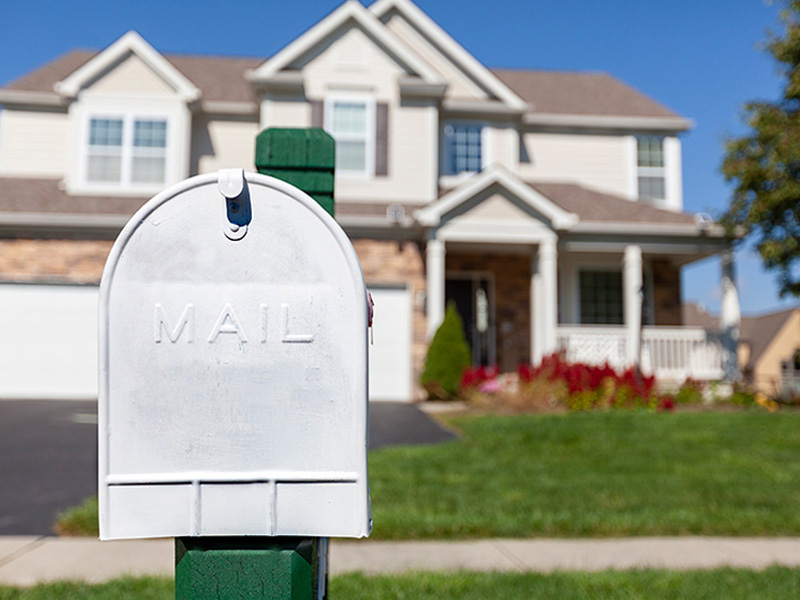
Home ownership plays critical roles in the economy, job markets, individual financial wealth, American culture, and lifestyles. All of those areas are undergoing significant changes, impacting the home sector in profound ways.
Low interest rates from 2012 to 2019 and record-low rates from 2020 to 2021 prompted waves of home buying, snatching up available homes in mass. Now, home mortgage interest rates have risen to levels not seen since the year 2000 and correspondingly, mortgage demand sits at a 27-year low. Overall, mortgage activity fell 25% versus the prior year.
In addition to high mortgage rates, a shortage of homes for sale has impacted the residential sector with new listings down to some of the lowest levels in decades. Homeowners with low interest loans obtained in prior years are unwilling to move, which would exchange those low rates for new, much higher rates. The lack of housing inventory has pushed home prices to high levels with many home sales producing bidding processes with final sales prices above the original asking prices.
 Home ownership plays critical roles in the economy, job markets, individual financial wealth, American culture, and lifestyles. All of those areas are undergoing significant changes, impacting the home sector in profound ways.
Home ownership plays critical roles in the economy, job markets, individual financial wealth, American culture, and lifestyles. All of those areas are undergoing significant changes, impacting the home sector in profound ways.
Low interest rates from 2012 to 2019 and record-low rates from 2020 to 2021 prompted waves of home buying, snatching up available homes in mass. Now, home mortgage interest rates have risen to levels not seen since the year 2000 and correspondingly, mortgage demand sits at a 27-year low. Overall, mortgage activity fell 25% versus the prior year.
In addition to high mortgage rates, a shortage of homes for sale has impacted the residential sector with new listings down to some of the lowest levels in decades. Homeowners with low interest loans obtained in prior years are unwilling to move, which would exchange those low rates for new, much higher rates. The lack of housing inventory has pushed home prices to high levels with many home sales producing bidding processes with final sales prices above the original asking prices.
- Interest rates: Higher rates lower home demand, but also lessen homebuilder volumes
- Labor shortages: A lack of skilled, experienced tradespeople across all trades
- Material availability: Lack of skilled labor affects manufacturers as well as upstream supply of inputs
- Environmental: Homeowners want environmentally responsible materials and practices
- Work from home: Space layouts changing with moves away from open floor plans, allowing quiet spaces
- Multifamily options: Many are choosing apartment life with its flexibility, economics, and amenities
- Renovations: Homeowners who are staying in place want more from their spaces
- Realtors: Headwinds with less homes to sell, high home prices & rates, and fewer buyers
- Homebuilders: Cautiously, eager to build homes for current, high prices but wary of a home price correction
- Home sellers: Fewer of them, but those who sell interested in higher sale prices
- Homebuyers: Concerned about prices and rates, looking for just the right home
- Home improvement retailers: Enjoying the explosion of home project volume
- Renovation contractors: Increasing project levels with trends and momentum behind them – Do-It-For-Me trend growing rather than DIY
Decision Makers and Project Planners
Homeowners are staying put and renovating their homes like never before. They want to expand and improve their homes, creating offices, recreation rooms, outdoor living areas, and much more. Their projects are more complex than traditional DIY efforts, leading many to reach out for professional help.
Homeowners, buyers, and sellers have interest in whether home prices will remain high, leading to the continuation of current trends. Most experts believe prices will remain high based on:
- Low number of available homes
- New home construction not meeting demand
- Millennial generation is large, many seeking homes
- Lending standards are strict, reducing customer numbers
- Foreclosures are low, reducing home turnover
The spike in home renovation work became a trend and now promises to be a recurring theme for homeowners. Many of those renovation projects involve new floor coverings with decision makers citing the following as guiding their decisions:
- Durability (67%)
- Attractive (61%)
- Easy to clean (58%)
- Affordable (49%)
- Adds value (45%)
The floor coverings used in homes are changing. Home owners report having the following coverings in their homes currently with interest in upgrades and new materials:
- Carpet (75%)
- Tile (58%)
- Wood (52%)
- Laminate (29%)
- Vinyl (26%)
The rise of LVT represents the strongest trend in floor coverings. Resilient coverings hold the largest share of covering sales with growth of 14% last year, making up 30% of flooring sales. Many residential subfloors are not ready to receive LVT coverings. Additional subfloor work is required, leading to subfloor work as a companion trend to rising LVT use in homes.
The Numbers
With a value of $52 trillion and overall square footage of 257 billion, US homes are the largest investment of most homeowners. New home construction employs 3.1 million people with 889,000 as builders and 2.2 million as specialty trade contractors. Residential square footage is 2.66 times larger than all commercial space combined and almost 16 times larger than all multifamily square footage.
FLOORS AND FACILITIES:
256.71 billion: Residential square footage
266%: Amount by which residential footage exceeds all of commercial
85 million: Houses in the US
3.1 million: Number employed building homes
1,022,000: Homes completed in 2022
2,299: Median size of homes completed in 2022
5.03 million: Homes sold in 2022
ECONOMIC STATS:
$51.9 trillion: Value of all US homes (all time high)
50%: Increase in overall home value since pre-pandemic
$407,100: Median sale price of homes sold
1.37 million: Number of homes in US for sale (40% less than 2019)
-25%: Reduction in new listings over prior year
33%: Portion of homes selling above list
FLOORS AND FACILITIES:
256.71 billion: Residential square footage
266%: Amount by which residential footage exceeds all of commercial
85 million: Houses in the US
3.1 million: number employed building homes
1,022,000: Homes completed in 2022
2,299: Median size of homes completed in 2022
5.03 million: Homes sold in 2022
ECONOMIC STATS:
$51.9 trillion: Value of all US homes (all time high)
50%: Increase in overall home value since pre-pandemic
$407,100: Median sale price of homes sold
1.37 million: Number of homes in US for sale (40% less than 2019)
-25%: Reduction in new listings over prior year
33%: Portion of homes selling above list
Subfloors, Project Needs, and Opportunities
While many homeowners are do-it-yourselfers, an increasing number want professionals to handle the projects. In addition, many others are making changes to floor coverings, requiring subfloor work to accommodate the different coverings. These trends paired with the vast size of US residential square footage make subfloor solutions a critical part of every flooring contractor’s project plans.
| Issue | Details | Schönox Solution |
|---|---|---|
| Quick project turns | Subfloor work completed quickly, making way for other trades | Schönox Need for Speed™ systems |
| Occupied homeowner spaces | Renovation work completed with homeowners present | Subfloor products with low dust and odor |
| Subfloor for LVT | Prepare subfloors to receive popular LVT coverings | Schönox Hybrids, Synthetic Gypsum, and Cement-Based self-leveling compounds |
| Adhesives for LVT | Adhesives integrated with the subfloor solutions for LVT and all other coverings | Schönox adhesives |
| Environmental priorities | Homeowners need subfloors with the highest environmental stewardship | The Schönox commitment to support environmentally-responsible projects |
| Subfloor renovation without demolition | Existing subfloors come with issues leading some to consider subfloor demolition | Schönox subfloor Renovation without Demolition |
| Concrete slab moisture | Moisture is the #1 subfloor problem, leading to floor failures | Schönox moisture mitigation systems |
| No HVAC | Homes under renovation with high humidity and temp due to no HVAC lead to slow drying times | Schönox Hybrid Active-Dry Technology |
With new home construction volume giving way to home remodeling as the greater focus in the residential sector, Schönox solutions will allow contractors to renovate subfloors, meeting the diverse goals of home projects.





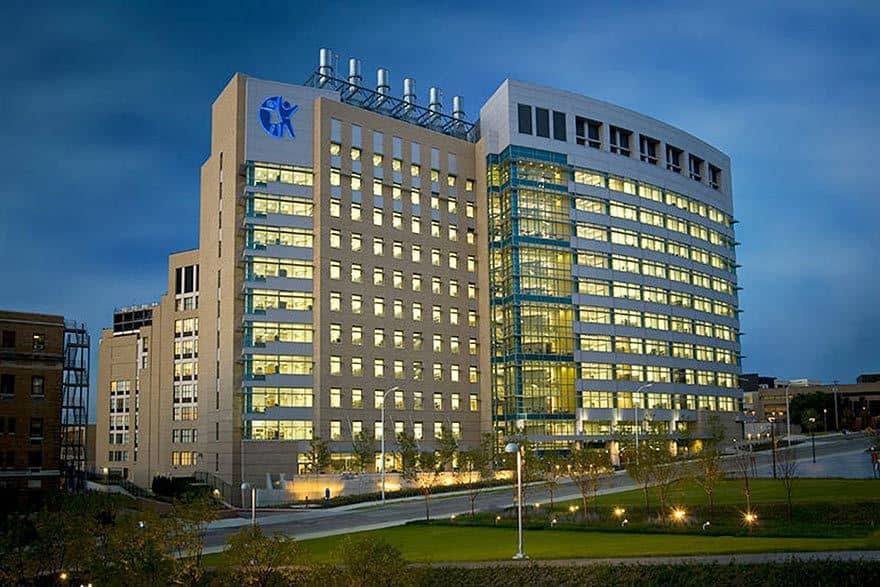
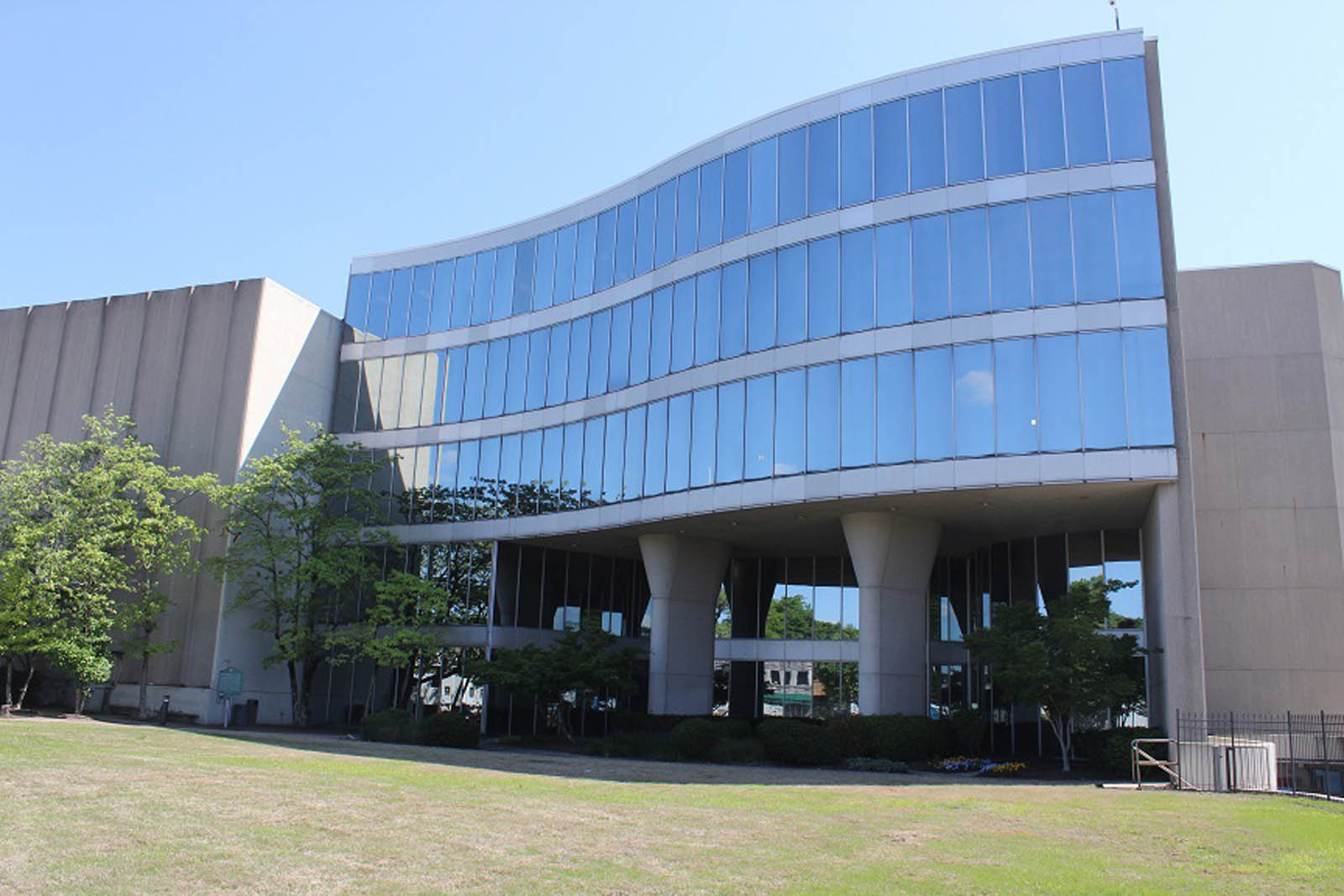
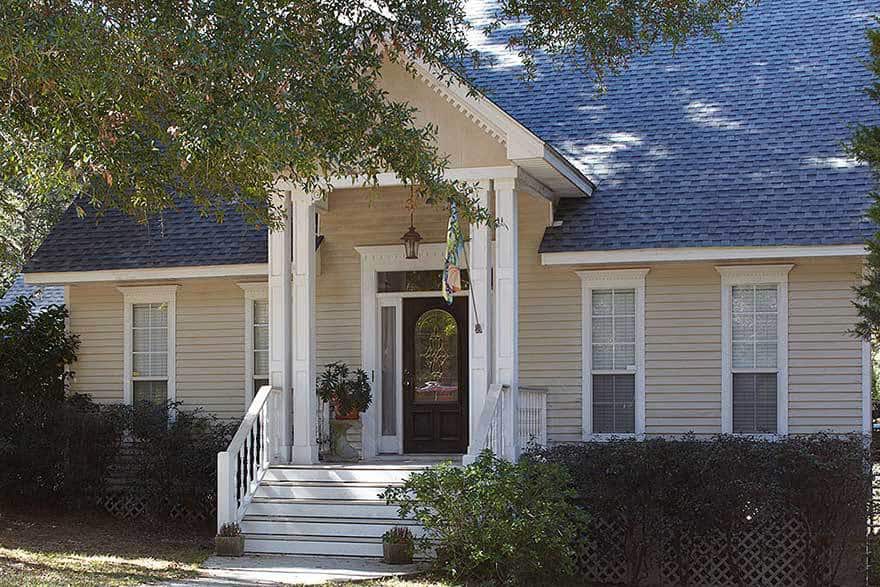
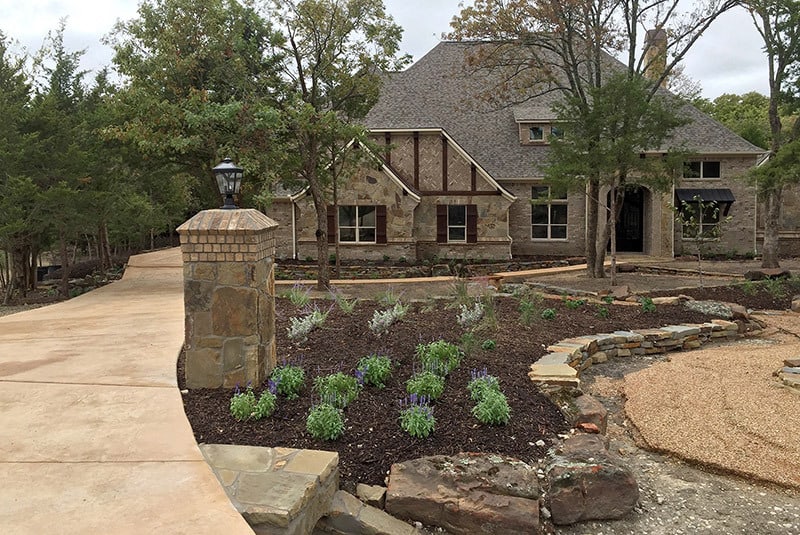

 We believe continuing education is the cornerstone to understanding new technology and techniques to better help with your next project.
We believe continuing education is the cornerstone to understanding new technology and techniques to better help with your next project.
